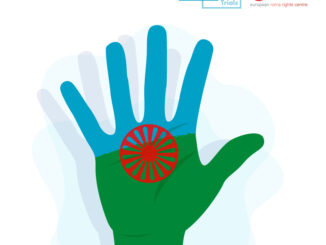
In Europe, the Romani people has long been seen as a deviant ethnic group that does not allow itself to be integrated into society and is synonymous with social problems. But how can we detect antigypsyism? A German research report gives interesting and current answers. The historian Jan Selling has read it.
(This is a translation of the article originally published in the Swedish Daily Dagens Nyheter 20 July 2021).
The final report of the German Bundestag’s Commission against Antigypsyism was recently presented. Unlike the Swedish commission led by Thomas Hammarberg in 2014-2016, the Germans were given resources to carry out major research efforts.
In short, the report says that antigypsyism is a widespread societal problem that can only be solved by really changing our point of view: it is not the Romani people who is the problem, but antigypsyism in all its structural and manifest variants. The majority society’s view of Roma – or what is perceived as ”being gypsy” – has been appallingly unchanged since the beginning of the Enlightenment, through the Holocaust genocide of Roma and into today’s debates on begging and Romani inclusion. The basic idea is that Roma are a fairly unified, and extremely divergent ethnic group that does not allow itself to be integrated and that is synonymous with social problems.
This view was already carved out by the earliest ”gypsyologists” (in German: “Tsiganilogen”). Johan Gottlieb Grellmann laid the foundation for his research on the state of research in his book Historischer Versuch über die Zigeuner 1787. Linguists had just proved that the ancestors of the Roma came from India, anthropologists had established that the Roma are an exotic ”scum” and found that in India there is a corresponding ”scum”, namely the socially excluded ”shudras”. Thus, the Roma must be descended from ”shudras”, Grellmann reasoned.
The move from India was used as proof that Roma are fundamentally nomads. Combined with the biologically racist notion that asociality is hereditary and can be linked to particular ”races” and ”racial mixtures”, this science, the dawning “gypsyology”, became a racist technology used by administrators of everything from assimilation to genocide. The bizarre combination of contempt and fascination is perhaps most evident in a quote by Josef Mengele, who the day after he sent 4,000 Roma to the gas chambers inspected the empty Roma barracks in Auschwitz on August 3, 1944 and exclaimed that he felt sorry for the loss of the Gypsy romance of the camp (”Schade um die Romantik des Zigeunerlagers”)
With this knowledge, it is surprising that the basic theses of gypsyology (Tsiganologie) can be quite boldly launched over and over again without risking being questioned.
An example is the book Zigeuner am schwarzen Meer which was published in 2008 by the research group Elena Marushiakova (2020 honorary doctor at Södertörn University), Veselin Popov, Bernhard Streck and Udo Mischek. The book is richly illustrated with colorful dancing women and men in large mustaches.
But is the book racist? One way to answer the question is to use the manual for detecting antigypsyism and racism in Roma-related research provided by the recent report from the German Bundestag’s Commission. Already the introduction to the book turns out to tick off most of the points:
1) Uncritical use of early gypsyologist (tsiganologische) or racist publications:
The book connects via the racial researcher Wilhelm Emil Mühlmann (Chiliasmus und Nativismus, 1961) to the mentioned thesis that Roma are related to Indian ”pariah groups” and should be studied as such.
2) Homogenisation of the group using the term “Zigeuner”, which the Commission describes as racist.
Already in the first sentence of the book, it is stated that it is the ”collective term ‘Zigeuner’ that should be used, even though the authors are aware that it is perceived as offensive.
3) ”Ethnicization and culturalization of social problems and romanticization of insecure life situations”.
In the book, the thesis is driven that ”Zigeuner” are basically a nomadic culture that seeks out ”nooks and crannies where the lights of the established castes, ranks and classes shine past. They do not belong anywhere, but yet they are at home everywhere”.
One chapter is called “Der Zauber des Nomadentums” (The Enchantment of Nomadism”).
4) Delegitimization of Romani self-organization.
The authors generally speak disparagingly of attempts at modern Roma self-organization in Eastern Europe that take place with the support of international Roma activism and call its representatives “Berufszigeuner“ (professional gypsies”).
5) The thesis that Roma are strongly deviant and inferior to the majority society.
The book is based on the thesis that ”Zigeuner” have ”nomadic values”, even if they have settled, and establishes the asymmetric exchange relationship: they (the ”Zigeuner”) need the majority society, but society does not need them.
A sixth feature of the Commission’s catalog is confirmed by Marushiakova and Popov in a 2017 publication: deprecation of antigypsyism-critical research. This describes research on Roma discrimination and the Holocaust as something that goes against the ”natural interests” of the Roma and is “exploited” to attract money from external financiers such as George Soros.
When it became known this spring that Marushiakova’s appointment as an honorary doctor was questioned by the entire department of Romani studies at Södertörn University, she chose to only comment via public posts on her and Popov’s Facebook page and clarified that she refuses to be examined by experts on antigypsyism because she considers antigypsyism research to be only a small insignificant field in Romani studies.
The honorary doctor’s evasive maneuver and Södertörn University’s inability to see racism in her research when she was appointed honorary doctor is reminiscent of the tale of The Emperor’s New Clothes. It is difficult to imagine that this could have happened in the present with any other form of racism.
JAN SELLING
Associate Professor in History, Head of Romani Studies Department at Södertörn University, Sweden
redaktionen@dikko.nu
REFERENCES:
Deutscher Bundestag (21/5/2021), ”Bericht der Unabhängigen Kommission Antiziganismus. Perspektivwechsel. Nachholende Gerechtigkeit. Partizipation”, Drucksache 19/30310. [https://dserver.bundestag.de/btd/19/303/1930310.pdf]
Marushiakova Elena, Udo Mischek, Vesselin Popov & Bernhard Streck (2008), Zigeuner am Schwarzen Meer. [https://eudora-verlag.de/de/product/zigeuner-am-schwarzen-meer-hgg-elena-marushiakova-udo-mischek-vesselin-popov-bernhard-streck/]
Marushiakova, Elena & Vesselin Popov (2017), ”Orientalism in Romani studies: the case of Eastern Europe”. In: Kyuchukov, Hristo & W New (eds), Languages of Resistance: Ian Hancock’s Contribution to Romani Studies. Lincom Europe.


